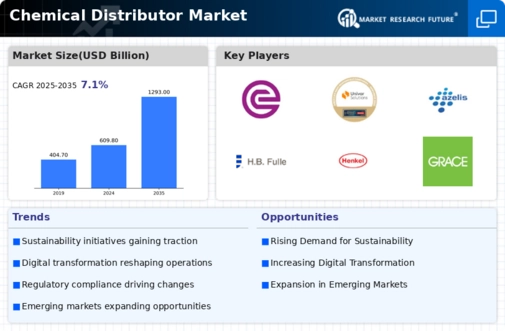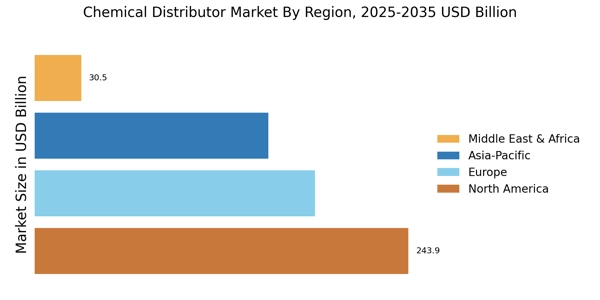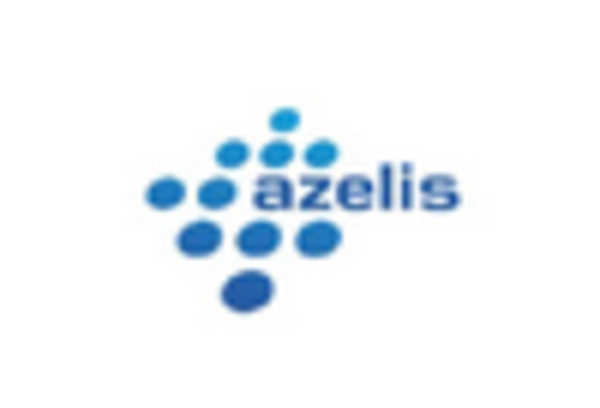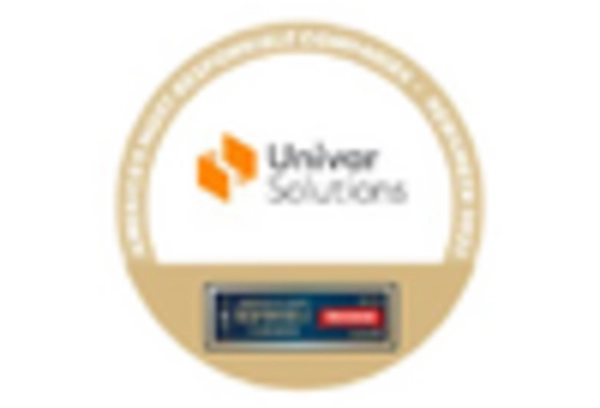Rising Demand for Specialty Chemicals
The Chemical Distributor Market experiences a notable increase in demand for specialty chemicals, driven by their applications across various sectors such as pharmaceuticals, agriculture, and personal care. As industries seek to enhance product performance and sustainability, the need for tailored chemical solutions becomes paramount. Reports indicate that the specialty chemicals segment is projected to grow at a compound annual growth rate of approximately 5.5% over the next five years. This growth is likely to compel distributors to adapt their offerings, ensuring they meet the evolving needs of manufacturers. Consequently, the Chemical Distributor Market must focus on sourcing and supplying high-quality specialty chemicals to remain competitive and responsive to market trends.
Regulatory Compliance and Safety Standards
The Chemical Distributor Market is significantly influenced by stringent regulatory compliance and safety standards imposed by various governmental bodies. These regulations are designed to ensure the safe handling, transportation, and storage of chemicals, thereby protecting public health and the environment. Distributors are required to invest in training and infrastructure to comply with these regulations, which can be both a challenge and an opportunity. The market is witnessing an increase in demand for distributors who can demonstrate compliance and provide safety data sheets, thereby enhancing their credibility. As regulations evolve, the Chemical Distributor Market must remain vigilant and proactive in adapting to these changes to maintain market access and customer trust.
Growth of E-commerce in Chemical Distribution
The Chemical Distributor Market is undergoing a transformation with the rise of e-commerce platforms that facilitate the online sale of chemicals. This trend is reshaping traditional distribution models, allowing for greater accessibility and convenience for customers. E-commerce enables distributors to reach a broader audience, streamline order processing, and reduce operational costs. Data suggests that the online chemical sales segment is expected to grow by over 20% in the coming years, indicating a shift in purchasing behavior among businesses. As a result, the Chemical Distributor Market must embrace digital transformation to enhance customer engagement and optimize supply chain efficiency.
Sustainability and Green Chemistry Initiatives
Sustainability is becoming a pivotal focus within the Chemical Distributor Market, as stakeholders increasingly prioritize environmentally friendly practices. The push for green chemistry and sustainable sourcing is reshaping the chemical supply chain, prompting distributors to offer eco-friendly alternatives. This shift is not only driven by regulatory pressures but also by consumer demand for sustainable products. Market analysis indicates that the green chemicals segment is projected to grow significantly, with an expected CAGR of around 10% over the next five years. Distributors that proactively incorporate sustainability into their operations are likely to gain a competitive edge in the Chemical Distributor Market, appealing to environmentally conscious customers and aligning with global sustainability goals.
Increased Investment in Research and Development
Investment in research and development (R&D) is a critical driver for the Chemical Distributor Market, as companies strive to innovate and develop new chemical products. This focus on R&D is essential for meeting the demands of various end-use industries, including automotive, electronics, and construction. Distributors that align with manufacturers engaged in R&D can benefit from exclusive partnerships and access to cutting-edge products. Furthermore, the market is witnessing a trend where companies allocate a higher percentage of their budgets to R&D, potentially leading to the introduction of novel chemicals and formulations. This dynamic creates opportunities for the Chemical Distributor Market to expand its portfolio and cater to emerging market needs.


















Leave a Comment